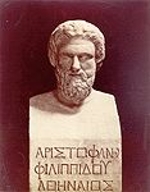Background for Aristophanes' The Clouds
Terminology
- komoidia: a komos song
- komos: A ritual carnival where normal patterns of behavior are set aside (Not unlike Mardi Gras). It involves partying, singing, dancing, drunkenness, masks, and costumes (including that of leather phalluses and animals), as well as ritual aischrologia; The exit scene of the comedy leads to general feasting afterward;
- prologus: opening section of the comedy that conceives of the initial idea;
- parodos: the entrance of the chorus;
- agon: the debate over the merits of the main idea, usually between two opposing actors;
- parabasis: "the coming forward." a scolding of the audience by the playwright, usually a separate speech little related to the overall idea of the comedy;
- aischrologia: verbal and physical abuse of individuals, often slapstick in nature;
- dinos: the view (held by Empedocles, Anaxagoras, and Democritus) that the central organizing power of the universe is a whirling vortex. [Our translation refers to this concept as "The Vortex".]

Aristophanes' Conservatism
- Aristophanes is typically associated with political, religious, and moral conservatism.
- He tends to hold up Athens of the Persian war period, distrusting the Athenian empire's involvement with other Greek city-states.
- He disapproves of mob rule.
- He upholds the worship of the traditional Greek gods.
- He decries the new learning as empty.
- He tends to stress feeling and piety over logical reason.
Portrait of Socrates
- He is presented as a Sophist concerned with false rhetoric and material success.
- He is presented as an atheist and a believer in dinos.
- He practices some aspects of mystery cult initiations (cf. Strepsiades' entry into the school.)
- He holds that thinking is somehow associated with air (a view held by Diogenes of Apollonia).
- He stresses the need for a study of poetic meter and grammar -- the stress of the New Education.
Question: How much did Aristophanes know about the real Socrates? Is his portrait intended to be accurate and/or farcical?
The New Education/ The Greek Enlightenment
The New Science: The philosophical beliefs of several; presocratic philosophers who held the world to be essentially governed by mechanistic forces (cf. dinos). For example, Empedocles held that the universe was driven by four opposing forces: "[W]hen Strife reaches the lowest depth of the whirlpool, and when Love comes to be in the middle of the whirl, in it (i.e. the whirl) all these things come together so as to be one — not all at once, but willingly combining from different directions." The views of some, such as Democritus, naturally influenced the Sophists: "The sweet exists by convention, the bitter by convention, the hot by convention, the cold by convention, color by convention; in actuality there exist only atoms and the void. [. . .] In actuality we perceive/understand nothing certain, but rather that which shifts according to the disposition of our body and of the things that enter it and press against it."
The New Rhetoric: The Sophists were not a unified group of teachers and educators, but they nonetheless held similar notions about truth and language. They stressed the systematic study of poetry, grammar, and public speaking. Most of them came to the position that ethics and mores were specific to local cultures and that no universal mores could be found across cultures. This lead to a stress on political change through public speaking. Protagoras is famous for believing that "[o]f all things the measure is man, of the things that exist, that they exist, and of the things that do not exist, that they do not exist." They were also often associated with a general skepticism about the reality of the Greek gods.
